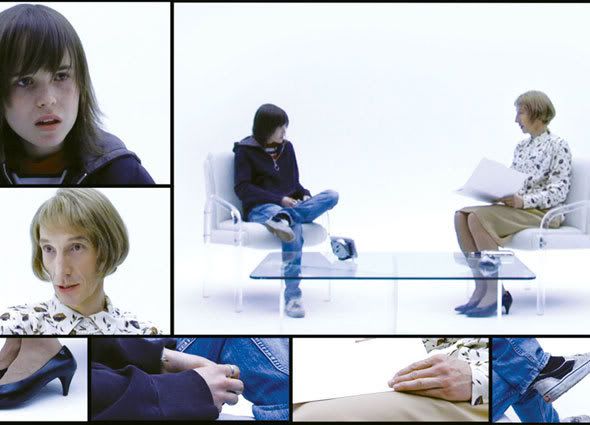
The media is an inescapable reality of today’s society. Throughout their lives, women are surrounded and saturated with television, radio, advertisement, news print, and internet in which women are underrepresented and over sexualized. The physical appearance and sexual aspect of women is over emphasized in the media. Media, like Cosmo or Seventeen Magazine, which is targeted to women revolves largely around sex, relationships, fashion, and beauty products. Exposure to these images during a sensitive period could have a large impact on mental health, the development of self image, and the development of social roles in adolescent women.
How are adolescent girls affected by over sexualization of women in the media? Do adolescent women develop different identities or social roles for themselves as a result of this presentation? Are the images of women in the media to blame for the increasing amount of adolescent females diagnosed with anxiety, depression, and eating disorders? Do these images have an effect on their mental health, body image, or sexual behavior?
For the purposes of this discussion:
• Poor mental health will be defined as having poor body image, self objectification, and internalizing problems. Internalizing problems may include anxiety, depression, and social withdrawal. (Peter & Valkenburg, 2007).
• Sexual behavior will include at what age an individual becomes sexually active, how sexually active they are, and their attitude toward being sexually active.
Adolescents, as defined by Erik Erikson’s psychosocial stages of development, spans the ages from eleven to eighteen and is a stage during which adolescents either develop a sense of identity or role confusion. During adolescents, according to Erikson, a person becomes concerned with how he or she is perceived by others. During this time the person develops identity if they feel confidant that their inner self matches their outer self, and they develop a sexual identity.

Self objectification is a feminist theory that women and girls internalize the image of women as sex objects, and the unrealistic images of thin women as the ideal. Women come to view themselves in terms of external perspectives. They define themselves as objects to be viewed, admired, and possessed (Aubrey, 2006). In Western culture the depiction is specifically sexual; women view themselves as sex objects for men to use, possess, and approve of. According to feminist theory, this self objectification leads to high levels of anxiety, body shame, and poor self esteem (Peirce, 1990).
Teens under the age of eighteen spend an average of between six and seven hours a day with mass media in some form. Older teens spend about twenty hours a week listening to music or watching music videos. In prime time television there is an average of about eight sexual incidents per hour. Women are primarily depicted as sex objects. In fact women are, “rarely portrayed as anything other than sexual objects to be lusted after or aggressed against.”(Brown& Witherspoon, 2002). Magazines and advertisements focus mainly on women’s bodies or body parts, sometimes omitting the woman’s head and face altogether. This focus on women’s bodies and body parts, contributes to the problem of self objectification. In television programming that is popular among adolescents, the second most common plot is women and girls being judged by their physical appearance and sexuality (Aubrey, 2006). This depiction leads adolescent women to judge themselves by this same appearance standard, rather than by their own values of talent, intelligence, or personality.

Despite the growing prevalence of television, music, and movies, magazines remain one of the most significant forms of media for adolescent women. Adolescent females rank magazines as second only to friends in importance as a source of information (Brown & Witherspoon, 2002). Seventeen Magazine, which is targeted directly to adolescent females, focuses on showing adolescent girls in sexual situations. It contains extensive cultural level scripts for romantic and sexual situations which have been revealed to oversimplify female sexuality, “to guide real-life sexual behavior and to perpetuate gender inequalities.” (Carpenter, 1998). Also, the scenarios often focus on sexual victimization, reminding readers of negative consequences of sexual behavior for females without mentioning similar consequences for males (Carpenter, 1998).


The ideal woman in the media is also becoming thinner and less realistic. In 1985, the average fashion model was a size eight; ten years later the average model had shrunk to between size zero and size two(Mundray & Ogden,1996).
A definite correlation has been drawn between a female’s exposure to media and their body image and mental health. In particular exposure to the thin, sexy ideal image, “results in a small, but statistically significant, increase in body dissatisfaction.”(Aubrey, 2006).
Magazines have been proven to be a reliable indicator of body satisfaction in adolescent females, and television is linked to anxiety, shame, self dissatisfaction, and eating disorders (Aubrey, 2006). This may be a result of the fact that these forms of media saturate adolescents with sexual, stereotypical images of women and impossible ideals of female beauty. The adolescent can not achieve these ideals, and can not reconcile what they see in the media with the values given to them by family, educators, and religious leaders. This discrepancy can lead to dissonance, which increases anxiety and depression.

The depiction of thin, sexy women in the media is closely associated with eating disorders, body dissatisfaction, shame, anxiety, and depression. Even more disturbing, it is increasingly common in adolescent females for body dissatisfaction to generalize into dissatisfaction with one’s self and one’s life (Miller, 2007). It is not surprising that being inundated with unrealistic images of women drive adolescents to self objectification, and extreme dieting in order to achieve the ideal. It is, however, important that adolescent males appear to be suffering from self objectification as well. The image of ideal men in the media emphasizes muscularity, with the depictions becoming more and more unrealistically muscular over the last 20 years (Good, Mills, Murnen, & Smolak, 2003).
Surprisingly, over sexualization of women in the media does not seem to affect adolescent female’s sexual behavior. While the media becomes more and more saturated with sexual material and images of females in sexual situations, the age at which teens become sexually active is actually getting higher, with females being older than males when they become sexually active. The United States still has a higher rate of teen pregnancy and STD infection in teens than European countries, but it is uncertain whether or not this can be linked to depiction in the media. (Berkey, Camargo, Colditz, Field, Roberts & Taylor, 2001).

It is clear that the image of women in the media needs to change. Instead of showing bodies and sexual images which are unrealistic and unhealthy, the portrayal of women should be expanded to include women of all ethnicities and body types with lives and identities which are valuable independent of appearance and sexuality.
Works Cited:
Aubrey, J. S. (2006). Exposure of sexually objectifying media and body self-perceptions among college women: An examination of the selective exposure hypothesis and the role of moderating variables. Sex Roles, 55(3-4), 159-172.
Bartini, M. (2006). Gender Role Flexibility in Early Adolescence: Developmental Change in Attitudes, Self-perceptions, and Behaviors. Sex Roles, 55, 233–245.
Berkey, C.S., Camargo, C.A., Colditz, G.A., Field, A.E., Roberts, S.B. & Taylor, C.B. (2001). Peer, parent, and media influences on the development of weight concerns and frequent dieting among preadolescent and adolescent girls and boys. Pediatrics,107(1), 54-60.
Brown, J. D. & Witherspoon, E. M. (2002). The mass media and American adolescents’ health. Journal of Adolescent Health, 31(6), 153-170.
Carpenter, L.M. (1998). From girls into women: Scripts for sexuality and romance in Seventeen magazine, 1974-1994. Journal of Sex Research, 35(2), 158-168.
Fitzharris, J. L., Morrissey, K. M. & Werner-Wilson, R. J. (2004). Adolescent and parent perceptions of media influence on adolescent sexuality. Adolescence, 39(154), 303-313.
Good, L., Mills, J.A., Murnen, S.K., & Smolak, L. (2003). Thin, sexy women and strong, mascular men: Grade-school children’s responses to objectified images of women and men. Sex Roles, 49(9-10), 427-437.
Hansbrough, E., Walker, E. & Ward, L. M. (2005). Contributions of music video exposure to black adolescents’ gender and sexual schemas. Journal of Adolescent Research, 20(2), 143-166.
Miller, M.A. (2007) Effects of highly sexualized images of women in visual media on adolescent females' objectified body consciousness and feminine ideology. (Doctoral dissertation, Walden University, 2007). Dissertation Abstracts International, 68, 1963 B.
Mundray, K. & Ogden, J. (1996). The effect of the media on body satisfaction: The role of gender and size. European Eating Disorders Review, 4(3), 171-182.
Peirce, K. (1990). A feminist theoretical perspective on the socialization of teenage girls through Seventeen Magazine. Sex Roles, 23(9-10), 491–500.
Peter, J. & Valkenburg, P. M. ( 2007). Adolescent’s Exposure to a Sexualized Media Environment and Their Notions of Women as Sex Objects. Sex Roles, 56(5-6), 381- 395.





